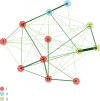Network Structure of Comorbidity Patterns in U.S. Adults with Depression: A National Study Based on Data from the Behavioral Risk Factor Surveillance System
- PMID: 37096248
- PMCID: PMC10122603
- DOI: 10.1155/2023/9969532
Network Structure of Comorbidity Patterns in U.S. Adults with Depression: A National Study Based on Data from the Behavioral Risk Factor Surveillance System
Abstract
Background: People with depression are at increased risk for comorbidities; however, the clustering of comorbidity patterns in these patients is still unclear.
Objective: The aim of the study was to identify latent comorbidity patterns and explore the comorbidity network structure that included 12 chronic conditions in adults diagnosed with depressive disorder.
Methods: A cross-sectional study was conducted based on secondary data from the 2017 behavioral risk factor surveillance system (BRFSS) covering all 50 American states. A sample of 89,209 U.S. participants, 29,079 men and 60,063 women aged 18 years or older, was considered using exploratory graphical analysis (EGA), a statistical graphical model that includes algorithms for grouping and factoring variables in a multivariate system of network relationships.
Results: The EGA findings show that the network presents 3 latent comorbidity patterns, i.e., that comorbidities are grouped into 3 factors. The first group was composed of 7 comorbidities (obesity, cancer, high blood pressure, high blood cholesterol, arthritis, kidney disease, and diabetes). The second pattern of latent comorbidity included the diagnosis of asthma and respiratory diseases. The last factor grouped 3 conditions (heart attack, coronary heart disease, and stroke). Hypertension reported higher measures of network centrality.
Conclusion: Associations between chronic conditions were reported; furthermore, they were grouped into 3 latent dimensions of comorbidity and reported network factor loadings. The implementation of care and treatment guidelines and protocols for patients with depressive symptomatology and multimorbidity is suggested.
Copyright © 2023 Cristian Ramos-Vera et al.
Conflict of interest statement
The authors declared no potential conflicts of interest with respect to the research, authorship, and/or publication of this article.
Figures



Similar articles
-
Identifying latent comorbidity patterns in adults with perceived cognitive impairment: Network findings from the behavioral risk factor surveillance system.Front Public Health. 2022 Sep 20;10:981944. doi: 10.3389/fpubh.2022.981944. eCollection 2022. Front Public Health. 2022. PMID: 36203679 Free PMC article.
-
Surveillance of certain health behaviors and conditions among states and selected local areas --- Behavioral Risk Factor Surveillance System, United States, 2009.MMWR Surveill Summ. 2011 Aug 19;60(9):1-250. MMWR Surveill Summ. 2011. PMID: 21849967
-
Surveillance for Certain Health Behaviors, Chronic Diseases, and Conditions, Access to Health Care, and Use of Preventive Health Services Among States and Selected Local Areas - Behavioral Risk Factor Surveillance System, United States, 2012.MMWR Surveill Summ. 2016 Apr 29;65(4):1-142. doi: 10.15585/mmwr.ss6504a1. MMWR Surveill Summ. 2016. PMID: 27124212
-
State-specific prevalence of selected chronic disease-related characteristics--Behavioral Risk Factor Surveillance System, 2001.MMWR Surveill Summ. 2003 Aug 22;52(8):1-80. MMWR Surveill Summ. 2003. PMID: 14532868
-
Surveillance for certain health behaviors among states and selected local areas--Behavioral Risk Factor Surveillance System, United States, 2011.MMWR Surveill Summ. 2014 Oct 24;63(9):1-149. MMWR Surveill Summ. 2014. PMID: 25340985
References
-
- World Health Organization. Depression [Internet] 2020. https://www.who.int/news-room/fact-sheets/detail/depression .
-
- GBD 2017 Causes of Death Collaborators. Global, regional, and national age-sex-specific mortality for 282 causes of death in 195 countries and territories, 1980-2017: a systematic analysis for the Global Burden of Disease Study 2017. The Lancet . 2018;392(10159):1736–1788. doi: 10.1016/S0140-6736(18)32203-7. - DOI - PMC - PubMed
-
- Organización Panamericana de Salud. La carga de los trastornos mentales en la Región de las Américas(The burden of mental disorders in the Region of the Americas) Organización Mundial de la Salud Oficina Regional para las Américas(World Health Organization Regional Office for the Americas); 2018. https://iris.paho.org/bitstream/handle/10665.2/49578/9789275320280_spa.p... .
LinkOut - more resources
Full Text Sources

